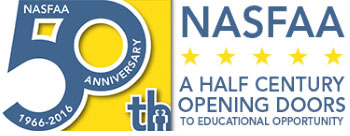50 Years in Financial Aid
It’s been 50 years since the Higher Education Act was first passed, opening doors around the country for students looking to better their lives through higher education. It also created the financial aid administration profession, a dedicated group of campus employees who help students achieve their educational potential by helping award and disburse monetary resources.
NASFAA is proud to recognize the following members who have been in the financial aid field for 50 or more years:
- Kenneth Fridsma
- P.N. Lanier
- Judith Lewis Logue
- Richard Tombaugh
If you have worked in financial aid for 50 years or more, please send an email to Membership Services so you can be added to this distinguished roster.
Judith Lewis Logue
Years in Financial Aid: 52
How long have you been working in financial aid and how did you get your start?
This is my 52nd year in financial aid administration. I have worked at three colleges over that period. As a graduating first-generation college student at San Diego State College (1960-64), I applied for a job at the University of Wisconsin – Madison. In spring 1964, I was hired (through the mail) by Wallace “Wally” Douma, the director of financial aid. When I met with Wally he explained that UW-Madison was one of a few universities to receive federal financial aid funds for 1964-65 and he was hired to create a financial aid office. He gave me a choice: I could take the job he had offered me in the Memorial Union or I could join him and a few other UW administrators and staff to create a financial aid office. Wally said he had a small budget for the new office, but he would have a bigger budget the next year. He said if I took the job with him, I’d probably take home about $200 per month. Since I had been making $1.25 an hour as a part-time student employee in the SDSC library, $200 per month sounded OK to me. I asked Wally, “Does that mean I’d be paid to give money to students who need it?” Wally said: “I guess you could look at it that way.” It was an easy decision for me. I joined Wally’s team.
What have been some of the most rewarding aspects of your career?
I have always felt very blessed to work in financial aid administration. I have personally witnessed what is possible in America. Over 52 years, I have witnessed first-hand how an American from a low-income family can use the financial aid system to get the education they need to succeed. I have had the privilege of encouraging and assisting first-generation college students of all ages and later, witnessing their amazing success. While I have assisted students from all economic circumstances, I have been able to focus on first-generation students over my entire career. I have been very grateful for that opportunity. If students get an education and work hard, they have the opportunity to reach their full potential. Their success is important to America and helps preserve democracy and the U.S. economy.
Financial aid has seen many significant changes over the last 50 years. What change do you think has made the largest impact on students?
The addition of the Basic Educational Opportunity Grant (BEOG) in the 1970’s.
What’s one change/improvement in financial aid that hasn’t happened in your career that you’d like to see happen?
While I am very grateful for the changes made over the last eight years regarding student loan repayment, I wish all loan forgiveness programs were not taxable – at least for undergraduate loans.
What advice would you give to a financial aid professional who is just starting out in their career?
Count your blessings. Financial aid administration is very challenging, but it is also very important and rewarding. I’ve always been grateful I earned a master’s degree in counseling and behavioral studies while working in the financial aid office at UW-Madison. It has served me well over my entire career. Money is a very emotional topic for everyone.
As you reflect on NASFAA’s 50-year history, how do you think the association has helped financial aid administrators?
In Wisconsin, Wally Douma played a major role in starting the Wisconsin Association of Financial Aid Administrators (WASFAA) in 1965. WASFAA was officially established in 1966 and Wally was the first president. Soon after, NASFAA was established and Allan Purdy was president. As a young person, I had the good fortune of learning from the early financial aid pioneers. I have always valued the associations. I am amazed by what NASFAA is able to do now for the financial aid profession. I feel Justin Draeger is the perfect NASFAA president and CEO for this era. I wish Allan Purdy was here to meet Justin and see what NASFAA does now!
P.N. Lanier
Years in Financial Aid: 50
How long have you been working in financial aid and how did you get your start?
I started my work in financial aid on August 29, 1966. I applied for a position and was invited to an interview with the vice president for student affairs. During this interview, it was determined that I really should be talking with the vice president for business and finance. I was told that I would be contacted regarding their decision. Before I left on that same day, I had been offered the job. That is when I found out that there was a problem in the three separate offices and with the three different people who were assigned to administer the National Defense Student Loan Program (Federal Carl D. Perkins Loan Program), the College Work-Study Program (Federal Work-Study Program) and the newly-created Basic Educational Opportunity Grant Program (Federal Supplemental Educational Opportunity Grant Program). The Department of Health, Education and Welfare (now the U.S. Department of Education) had given the college one year to correct the problem or make a significant effort to correct the problem. The Department returned one year later, and accepted the efforts made to correct the problem. Since the job was not finished, that college offered me a permanent job so that I could complete the project and set up a financial aid office, which would include all of the federal student financial aid programs, centrally located, as the Higher Education Amendments of 1965 had recommended.
What have been some of the most rewarding aspects of your career?
Cleaning up a major problem at a school, which if not corrected, would have resulted in the possible exclusion from further participation. Having that school selected among the schools permitted to participate in the Federal Direct Student Loan program in the group permitted to participate the second year (105 new participants). Also, our default rate and other operational aspects were low enough or met the criteria so that our participation was at the highest level. I have also enjoyed watching each year as new students arrived on campus as rough, unpolished gems, and watching them leave four years later as finished, highly-expensive, polished diamonds. I have had some parents call me up years later after their sons and daughters had graduated to say thank you, and give me an updated report on their current academic pursuits (working on a master’s or a Doctor of Philosophy degree, or in medical school or law school, or serving our country in a distant land). It always makes me happy to know how much I had become a part of their futures.
Financial aid has seen many significant changes over the last 50 years. What change do you think has made the largest impact on students?
The automation of the delivery system. Students do not have to send their Student Aid Reports to the college of their choice. Schools do not have to fill in bubble spots on the Student Aid Reports, batch these records and send them to the processing center for payment. Students and their parents do not have to pay ACT or CSS to have their need for aid processed. The increases in funding (still not sufficient) have enabled more students to secure the funds and to cover more of their educational cost. The implementation of using prior-prior year (PPY) tax data on the FAFSA could enable schools to send out award letters involving federal student aid much earlier than in past years.
What’s one change or improvement in financial aid that hasn’t happened in your career that you’d like to see happen?
I would like to see the elimination of so much waste of these funds when students fail to complete their degree programs, to provide more grant and work-study funds and alternatives to the repayment of a loan. I’d also like to eliminate financial aid as we now know it and provide every high school graduate with a voucher, which could be used to pursue a college degree, enter a trade school, enter a program where the recipient is attached to a skilled worker and receives on-the-job training, or to start a business, etc.
What advice would you give to a financial aid professional who is just starting out in their career?
For many students, you hold their future progress in your hand. Always remember that your job is to help individuals find a way to finance their education. Try as best you can to find a means for helping them rather than throwing up a road block or an obstacle to their ability to achieve their goals. Try to treat everyone equally – remember that these individuals are our fellow countrymen. We need their input, their vision, and their energy to help make and keep our country strong.
As you reflect on NASFAA’s 50-year history, how do you think the association has helped financial aid administrators?
When I came into financial aid 50 years ago, there were a few organizations providing help and training to individuals entering the financial aid profession. NASFAA, along with regional and state organizations, brough training, contact with fellow aid administrators, advice, and a single voice that shaped and influenced legislation on behalf of students, their parents, and educational institutions. Collectively, NASFAA and its member institutions have expanded the federal aid programs, increased the dollars available, made the legislation regarding the programs easier to implement, and have been a major factor in helping to educate students.

